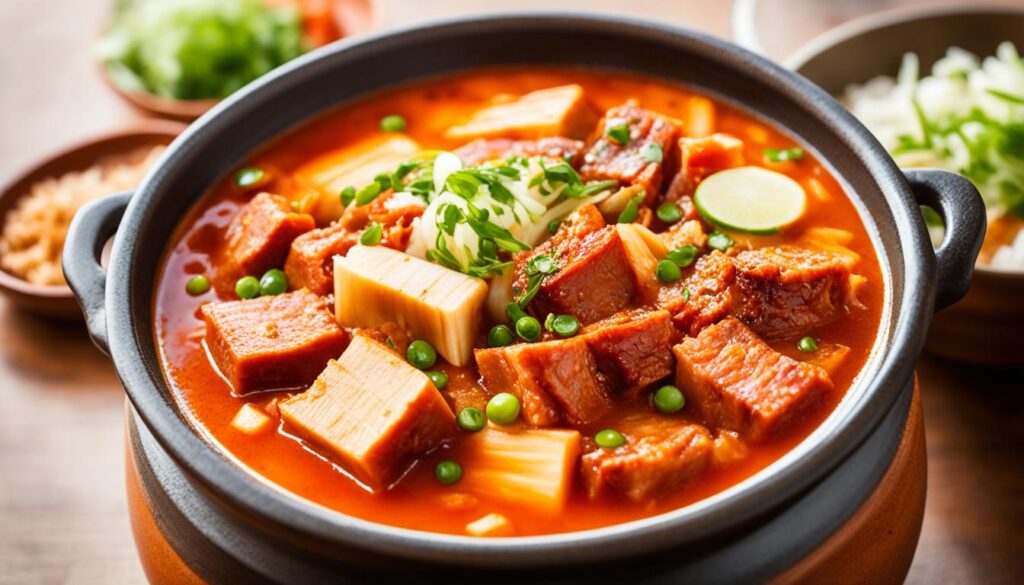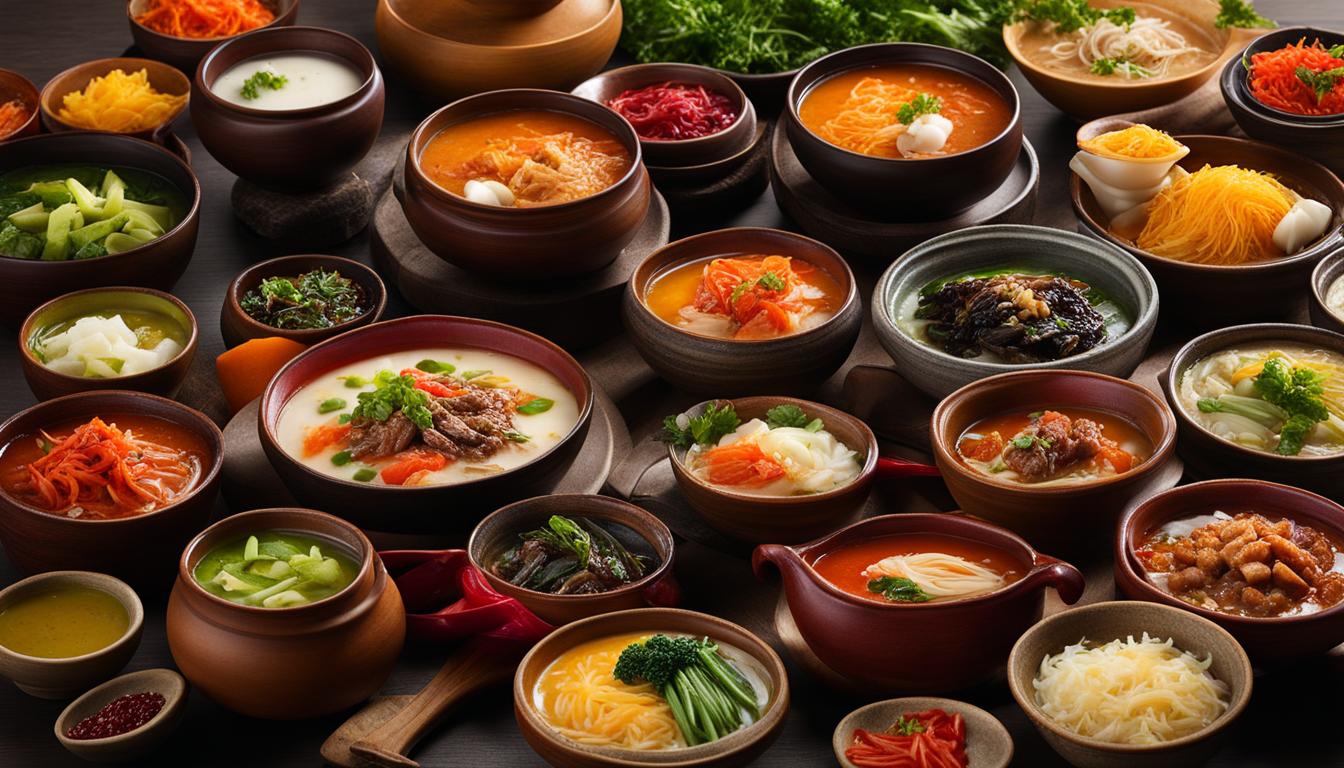When it comes to Korean cuisine, we often think of popular dishes like kimchi, bibimbap, and bulgogi. But have you ever wondered about the diverse world of Korean soups and stews? From light and refreshing guk, to rich and flavorful tang, and the robust and intense jjigae, Korean soups and stews offer an array of flavors and ingredients that will leave you craving for more. So, what makes these soups and stews so special? And which types should you try first? Let’s dive into the world of Korean soups and stews and discover the tantalizing answers.
Understanding Korean Soups: Guk and Tang
Korean soups offer a diverse range of flavors and textures that cater to different preferences. Among these, two primary types of soups stand out: guk and tang.
Guk: Light and Refreshing
Guk is a traditional Korean soup characterized by its thin consistency and a higher ratio of liquid to solid ingredients. This type of soup is typically served individually alongside a bowl of rice. Guk is beloved for its light and refreshing flavors, making it a popular choice for a nourishing meal.
Guk often incorporates a variety of ingredients, including vegetables, meat, and seafood, resulting in delightful and balanced flavors. It showcases the essence of Korean cuisine by highlighting the natural flavors of the ingredients. Whether it’s a simple seaweed soup or a more complex beef broth soup, guk provides a comforting and aromatic experience.
Tang: Rich and Flavorful
Tang, on the other hand, is a type of Korean soup that boasts a longer cooking time, resulting in a rich and flavorful broth. Unlike guk, tang can be served in individual portions or as a communal dish to be shared among family and friends.
Tang emphasizes the deep, umami-rich flavors derived from slowly simmering ingredients like beef ribs, fish, or vegetables. The extended cooking time allows the flavors to meld together, creating a broth that is robust and satisfying. It is no wonder that tang is considered a staple in Korean households, especially during cold winter months.
Exploring Korean Guk and Tang Dishes
To give you a glimpse of the diverse flavors offered by Korean guk and tang, here is a table showcasing some popular examples:
| Guk | Tang |
|---|---|
| Seaweed Soup (Miyeok Guk) | Beef Bone Soup (Seolleongtang) |
| Mung Bean Sprout Soup (Sukju Namul Guk) | Spicy Pollack Soup (Agujjim) |
| Oyster Soup (Gul Guk) | Mackerel Pike Soup (Dongtae Guk) |
These traditional soups exemplify the beauty of Korean cuisine, highlighting the use of local ingredients and centuries-old cooking techniques. Each soup offers a unique blend of flavors and textures, satisfying different taste preferences.
Whether you’re seeking a light and refreshing guk or a rich and flavorful tang, exploring the world of Korean soups will surely delight your palate and unveil the true essence of Korean culinary tradition.
Exploring Korean Stews: Jjigae
Jjigae is a type of Korean stew that offers a satisfying and flavorful dining experience. With its thick and hearty consistency, jjigae stands out from other soups and stews in Korean cuisine. This popular dish features a higher ratio of solid ingredients to liquid, resulting in a stew that is both filling and rich in flavor.
When it comes to jjigae, the options are endless. From traditional recipes passed down through generations to modern variations with unique twists, there is a jjigae for every palate. Vegetables, tofu, meat, and seafood are commonly used in jjigae, providing a diverse range of flavors and textures.
Seasonings play a crucial role in enhancing the taste of jjigae. Soy sauce, gochugaru (red pepper flakes), and other spices add depth and complexity to the stew, creating an explosion of flavors that leave a lasting impression.
Jjigae can be enjoyed as a standalone dish or as part of a shared meal. Gathering around a simmering pot of jjigae with loved ones not only warms the body but also fosters a sense of togetherness and connection. It is a communal dining experience that brings people closer, both literally and figuratively.
Some popular varieties of jjigae include:
- Kimchi Jjigae: Made with fermented kimchi, this spicy and tangy stew is a staple in Korean households.
- Soondubu Jjigae: With its silky soft tofu and fiery broth, this spicy tofu stew is perfect for those who crave a kick of heat.
- Doenjang Jjigae: Made with fermented soybean paste, this stew offers a deep and savory flavor that lingers on the palate.
These authentic jjigae recipes exemplify the bold and robust flavors that make Korean stews so beloved.

Popular Varieties of Jjigae
| Jjigae Varieties | Main Ingredients | Flavor Profile |
|---|---|---|
| Kimchi Jjigae | Fermented kimchi, pork or beef | Spicy, tangy |
| Soondubu Jjigae | Soft tofu, beef, seafood, vegetables | Spicy, savory |
| Doenjang Jjigae | Fermented soybean paste, vegetables, tofu | Savory, umami |
These popular jjigae varieties showcase the diverse range of flavors and ingredients that define Korean stews. Whether you prefer the heat of kimchi jjigae or the comforting richness of doenjang jjigae, there is a jjigae recipe to satisfy every craving.
Must-Try Korean Soup and Stew Recipes
To experience the delicious flavors of Korean soups and stews, here are some must-try recipes:
- Soondubu Jjigae: A spicy tofu stew made with soft tofu, beef, seafood, and vegetables in a flavorful broth.
- Kimchi Jjigae: A stew made with fermented kimchi mixed with pork or beef, creating a spicy and tangy flavor.
- Daenjang Jjigae: A savory stew made with fermented miso paste, vegetables, and tofu, offering a rich and deep flavor.
- Kongbiji Jjigae: A unique stew made with ground-up soybeans or soy pulp, pork ribs, and garlic, resulting in a rich and nutty taste.
- Ahl Jjigae: A stew made with seasoned pollack roe, broth, tofu, and red pepper flakes, providing a seafood flavor with a hint of spice.
- Budae Jjigae: A fusion stew that originated during the Korean War, featuring a mix of American ingredients like Spam and hot dogs with traditional Korean flavors.
These recipes showcase the diverse and delicious flavors of Korean soups and stews and are sure to satisfy any craving for hearty and comforting meals.
| Recipe | Description |
|---|---|
| Soondubu Jjigae | A spicy tofu stew made with soft tofu, beef, seafood, and vegetables in a flavorful broth. |
| Kimchi Jjigae | A stew made with fermented kimchi mixed with pork or beef, creating a spicy and tangy flavor. |
| Daenjang Jjigae | A savory stew made with fermented miso paste, vegetables, and tofu, offering a rich and deep flavor. |
| Kongbiji Jjigae | A unique stew made with ground-up soybeans or soy pulp, pork ribs, and garlic, resulting in a rich and nutty taste. |
| Ahl Jjigae | A stew made with seasoned pollack roe, broth, tofu, and red pepper flakes, providing a seafood flavor with a hint of spice. |
| Budae Jjigae | A fusion stew that originated during the Korean War, featuring a mix of American ingredients like Spam and hot dogs with traditional Korean flavors. |
Enjoying Korean Soup Culture
Korean soup culture is deeply ingrained in Korean cuisine, showcasing the country’s rich culinary tradition. Traditional Korean soups and stews are enjoyed throughout the year, providing comfort and nourishment to people of all ages.
Whether you’re savoring a bowl of refreshing guk on a scorching summer day or warming up with a hearty jjigae during the winter months, Korean soups and stews have become an integral part of Korean dining culture.
Indulge in the wide variety of traditional Korean soups, which feature a plethora of flavors and ingredients. From the delicate and light broths of guk to the robust and intense flavors of jjigae, each soup offers a unique and satisfying experience.
Immerse yourself in the authentic Korean stew recipes that have been passed down through generations. Discover the best Korean soup dishes that will delight your taste buds and transport you to the vibrant streets of Seoul. Embrace the flavors and traditions of Korean cuisine as you embark on a culinary journey through the world of traditional Korean soups and stews.
